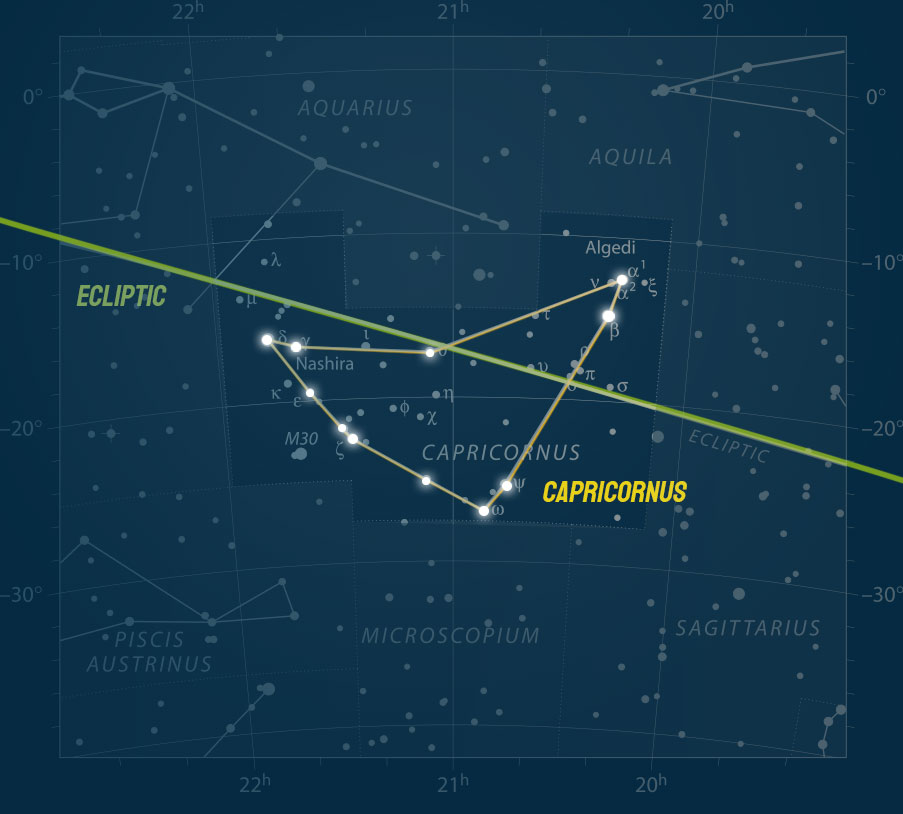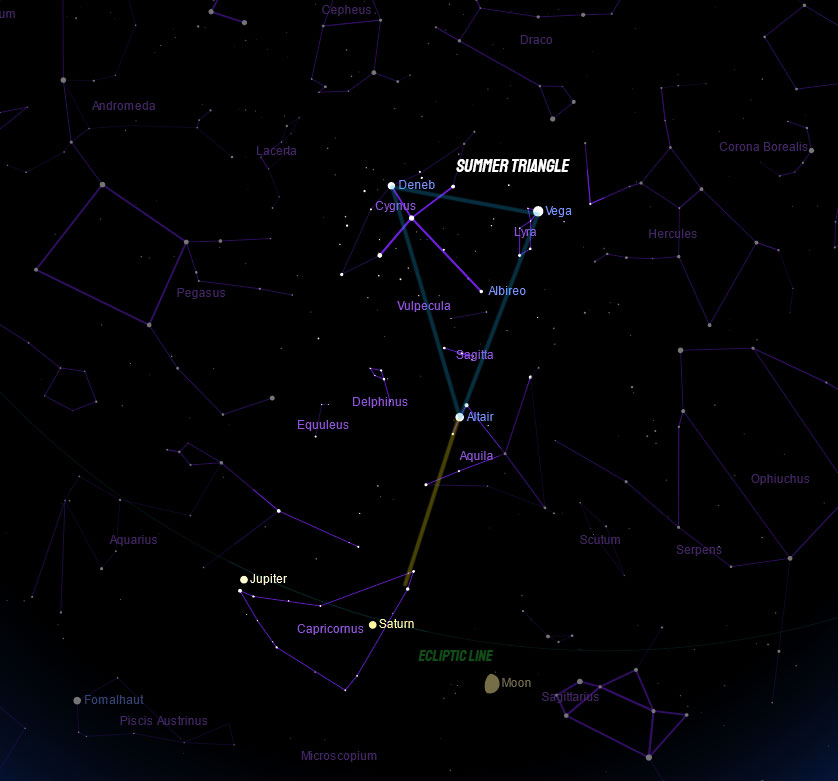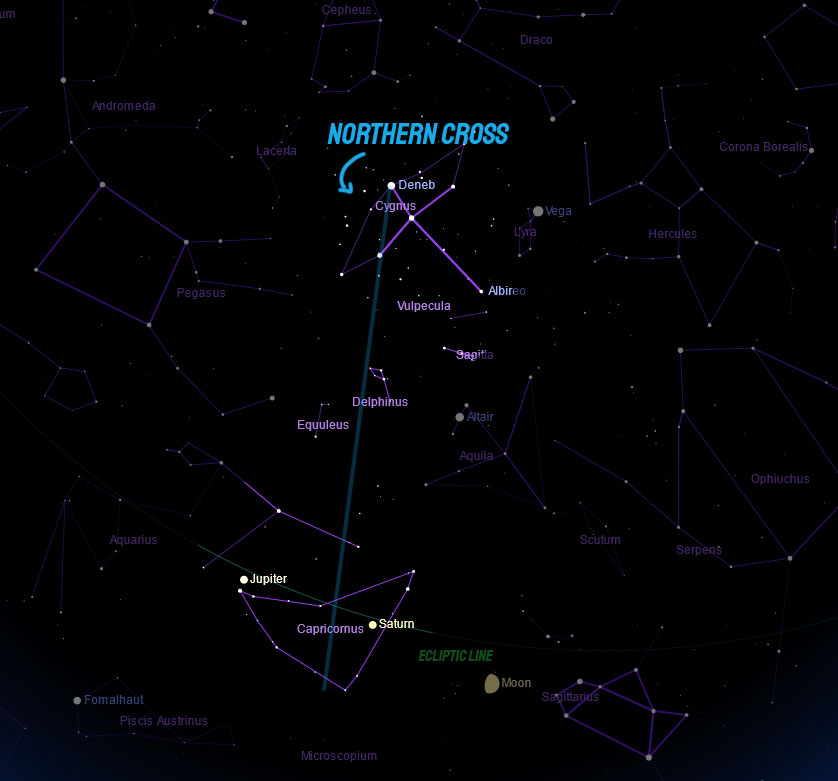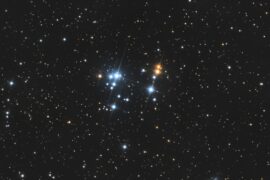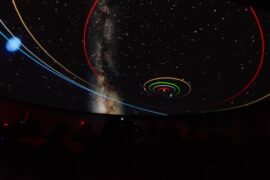Stargazing is a really fun activity and learning to locate the constellation without the help of a star map or a telescope is one of the easiest steps you can take to get started with the hobby.
The Capricornus constellation is one of the twelve zodiac constellations, and because of this, many people like to learn to find it, maybe because it’s their astrological sign, or because they like the mythology behind it. Whatever your reason is, in this article, we are going to show you 3 different methods you can use to locate Capricornus.
Capricornus is sometimes also referred to as Capricorn. In general, the term Capricorn is used to refer to the astrological sign, while Capricornus is used for the constellation, but they can be used interchangeably.
Here’s some general data about the constellation.
| Name | Capricornus |
| Abbreviation | Cap |
| Genitive | Capricorni |
| Meaning | The horned goat or goat’s horn |
| Main stars | 9 |
| Bayer stars | 49 |
| Discovered stars with planets | 5 |
| Brightest star | Deneb Algedi (Delta Capricorni) |
| Location | Quadrant SQ4 |
| Visible latitudes | +60 to -90 |
| Meteor showers | Alpha Capricornids, Chi Capricornids, Tau Capricornids, Sigma Capricornids |
| Neighboring constellations | Sagittarius, Aquila, Microscopium, Pisces |
When and where is the Saggitarius constellation visible
Capricornus is visible in the sky between April and December. The best time to watch it is during September when it can be found directly overhead at around 9:00 PM.
Between January and March, Capricornus passes behind the Sun, making it impossible for us from Earth to observe it during these months.
Capricornus is found in the southern square SQ4 in the sky and can be seen between the latitudes of +60 to -90, making it slightly easier to observe from the Southern hemisphere. Still, it can be seen from most of the Northern hemisphere with the exception of places closer to the pole like Alaska, Northern Russia, or Norway.
The following table details the times and general direction where Capricorn can be found each month in the U.S., UK, and Canada. The times might vary a bit depending on your location but not by much.
| Month | Visible |
|---|---|
| January | not visible |
| February | not visible |
| March | not visible |
| April | Rises in the southeast around 4:00 AM; visible until sunrise |
| May | Rises in the southeast around 2:00 AM; visible until sunrise |
| June | Rises in the southeast around 00:00 AM; before sunrise can be seen facing south |
| July | Rises in the southeast around 10:00 PM; before sunrise can be found to the southwest |
| August | Rises in the southeast around 8:00 PM; sets in the southwest around 5:30 AM |
| September | Can be seen in the southeast at sunset; sets in the southwest around 3:30 AM |
| October | Can be seen in the southeast at sunset; sets in the southwest around 00:00 AM |
| November | Can be seen to the south at sunset; sets in the southwest around 11:00 PM |
| December | Can be seen in the southwest at sunset; sets in the southwest around 9:00 PM |
Just like the Sun and the Moon, constellations also rise in the East and set in the West. There are some months (September to December) when Capricornus will already be up in the sky by sunset so you won’t be able to see it rising to the East.
It can be difficult to see Capricornus from big cities with the naked eye due to light pollution because its stars are not too bright. In those locations, you might need help from a telescope, or at least a good pair of binoculars. In rural areas, you should not have a problem seeing it as long as the weather conditions allow for it.
How to find Capricornus in the night sky
Capricornus can be tricky to locate because none of its stars are particularly bright. Its brightest star is Delta Capricorni, which, for comparison, is barely brighter than Jupiter seen from Earth.
The shape of Capricornus is easy to recognize as it looks kind of like a triangle, but some help is generally necessary in order to find it.
Here are 3 different methods to do so.
Method 1: Locate the ecliptic
All the zodiac constellations are located across an imaginary line called the ecliptic line, or ecliptic plane.
The ecliptic is simply the path Earth follows as it orbits the Sun.
If you can trace the ecliptic plane, you will be able to see every zodiac constellation that is visible at that point of the night.
The inconvenient part is that finding the ecliptic plane can take a bit of patience or watching the sky at specific times.
There are multiple ways to find the ecliptic, but the easiest one is to follow the Moon’s path and extend it. The Moon almost follows the same path as the ecliptic. It is slightly off, but it is close enough that you can use that line as a reference.
Another slightly more precise method requires you to watch the sky exactly at sunset. First look to the West where the Sun is setting. Just above the Sun, you will see a very bright dot, this isn’t a star, this is Venus. Look to the other side to the East where the Moon is rising. The imaginary line between Venus and the Moon is the ecliptic.
Once you have located the ecliptic, simply follow it and try to recognize the shapes of the constellations around it. Capricorn’s neighbor, Saggitarius might be a bit easier to recognize. Once you find it, Capricornus should be immediately beside it.
Method 2: The Summer triangle
This method works best, as the name implies, during the Summer months.
When you look overhead around midnight during Summer, you will see a very easy to recognize triangle formed by 3 very bright stars. These are Deneb, Altair, and Vega. These stars each form part of a different constellation, but they form the asterism known as the Summer triangle.
The Summer triangle can be used to easily star-hop to Capricornus.
Once you have located the triangle find its second longest side. This is the side formed by Vega and Altair. Connect them and extend that imaginary line in the direction of Altair.
This line will point exactly in the direction of Capricornus.
The Summer triangle can also be found beyond Summer, here are some tips on where to find it:
- During Spring, it is located to the East after midnight and until sunrise.
- During Autumn, it can be found to the West.
- It is not visible or barely visible on the Winter months.
Method 3: The Northern Cross
This method uses another asterism as a starting point to guide yourself.
The Northern cross is part of the Cygnus constellation. It is one of the most recognizable formations in the night sky that are not official constellations. As its name implies, it looks like one big cross in the sky and is easier to find in the Northern hemisphere.
The long side of the cross goes from the stars Deneb to Abireo. The short side goes from Delta Cygny to Gineah.
Trace an imaginary from Deneb, to Gineah.
If you have trouble differentiating which “side” is Gineah, Deneb (the brighter of all these stars) is slightly tilted towards one of the sides. Gineah is in the opposite one.
Extend the line between Deneb and Gineah, in the direction of Gineah which should be to the South. Follow it and this line splits Capricornus in half.
This method is even easier if you have a general idea of where the ecliptic line (see method 1) is located.
Summary
- Capricornus is a dim constellation
- It can be seend in the night sky from April to December
- The Northern cross and Summer triangle asterisms can be used to star-hop to Capricornus
How to find more constellations
Aries – Taurus – Gemini – Cancer – Leo – Virgo – Libra – Scorpius – Saggitarius – Capricornus – Aquarius – Pisces
Enjoyed this article?
Get daily 10-minute PDFs about astronomy to read before bed!
Sign up for our upcoming micro-learning service where you will learn something new about space and beyond every day while winding down.


